Photography
07-15-12 Frank (Revisited and Reworked)
 When I check the viewing statistics of my photo blog, I can see which photos are viewed most often and and what links brought people to my web site. Last week I noticed that my post from a while ago called "Frank" was getting the most hits, which were coming from another web site called Facepunch.com. Facepunch seems to cater to a broad set of interests, including the graphic arts.It turns out that a user who calls himself Bakyte had posted a reworked version of my photo that looks like this:
When I check the viewing statistics of my photo blog, I can see which photos are viewed most often and and what links brought people to my web site. Last week I noticed that my post from a while ago called "Frank" was getting the most hits, which were coming from another web site called Facepunch.com. Facepunch seems to cater to a broad set of interests, including the graphic arts.It turns out that a user who calls himself Bakyte had posted a reworked version of my photo that looks like this: And then the citizens of the forum were encouraged to fill in the blank.Before I reveal a few of my favorites, I would like to mention that all of my posts are shared through a Creative Commons copyright that allows for use as long as credit is given, no money is made and the original work is not altered. I don't want to sound selfish, but Bakyte violated at least two of those provisions. I did politely inform him of my concerns and he politely said he would try to remove the posts if he could.That aside, I enjoyed many of the modifications and will share four of my favorites:
And then the citizens of the forum were encouraged to fill in the blank.Before I reveal a few of my favorites, I would like to mention that all of my posts are shared through a Creative Commons copyright that allows for use as long as credit is given, no money is made and the original work is not altered. I don't want to sound selfish, but Bakyte violated at least two of those provisions. I did politely inform him of my concerns and he politely said he would try to remove the posts if he could.That aside, I enjoyed many of the modifications and will share four of my favorites:

 And last, one that was inspired by the group A Ha's song "Take On Me":
And last, one that was inspired by the group A Ha's song "Take On Me": And why not watch the A-Ha official "Take On Me" video? It was aired on MTV in 1985, won many awards and is a brilliant display of the animator's art. It also does a brilliant job of linking a fascinating visual story with a song that is otherwise insipid! In some ways, that's what MTV was all about in the 80s . . .The work of art, incidentally is called Frank, by Chuck Close. It is a photorealistic painting of a photo of a guy named Frank.
And why not watch the A-Ha official "Take On Me" video? It was aired on MTV in 1985, won many awards and is a brilliant display of the animator's art. It also does a brilliant job of linking a fascinating visual story with a song that is otherwise insipid! In some ways, that's what MTV was all about in the 80s . . .The work of art, incidentally is called Frank, by Chuck Close. It is a photorealistic painting of a photo of a guy named Frank.
6-30-12 Daisy, Daisy, daisy
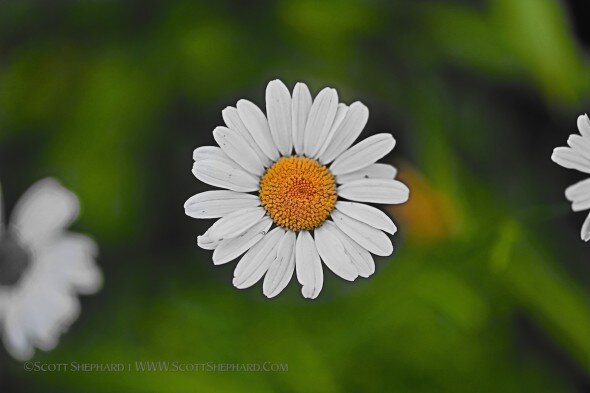 Not counting the parts of daisies on edges of this photo, there really are three daisies in this photo. "Really?!" you say. Really. This is a layered HDR photo that I made (not took) with my Canon 5D Mark III. It has HDR capacity built in. The things you can do with the new-fangled cameras. . .Incidentally, the title of this post pays homage to the famous scene in Stanley Kubrick's fiLm "2001: A Space Odyssey," where an astronaut "kills" HAL, the on-board computer. (HAL, by the way, is an acronym that is only one letter away from IBM. Coincidence?).When that film came out in 1968, 2001 seemed so far away. And now it's 2012 and we have cameras that are smarter than those who use them. Like me and my 5DIII. . .
Not counting the parts of daisies on edges of this photo, there really are three daisies in this photo. "Really?!" you say. Really. This is a layered HDR photo that I made (not took) with my Canon 5D Mark III. It has HDR capacity built in. The things you can do with the new-fangled cameras. . .Incidentally, the title of this post pays homage to the famous scene in Stanley Kubrick's fiLm "2001: A Space Odyssey," where an astronaut "kills" HAL, the on-board computer. (HAL, by the way, is an acronym that is only one letter away from IBM. Coincidence?).When that film came out in 1968, 2001 seemed so far away. And now it's 2012 and we have cameras that are smarter than those who use them. Like me and my 5DIII. . .
06-27-12 Sadness
 What you see in this photo is a pile of debris in the middle of a cornfield. But what I see is much more, for this pile is all that remains of a farmstead north of Watertown, South Dakota, that had become for me a place of photographic pilgrimage.This farmstead had an old house, a fairly large barn and two other out buildings that were part of the farming operation years ago. The buildings were subjects hundreds of photos I have taken. It was also what I called "the north studio," because I took many of my senior portrait subjects to this location due to its wealth of good locations for pictures. More recently, I took some of my LATI photo students there to share this great location. The photos they took are likely the last photos that were taken of this South Dakota relic.The group Kansas was right when they sang that "Nothing lasts forever but the earth and sky." And so I suppose it was inevitable that an abandoned farm would be bulldozed and turned into crop land. But I feel like I've lost a friend. This place had an important place in my personal history and it had a soul that had become part of my soul.But at least I have the photos. . . .
What you see in this photo is a pile of debris in the middle of a cornfield. But what I see is much more, for this pile is all that remains of a farmstead north of Watertown, South Dakota, that had become for me a place of photographic pilgrimage.This farmstead had an old house, a fairly large barn and two other out buildings that were part of the farming operation years ago. The buildings were subjects hundreds of photos I have taken. It was also what I called "the north studio," because I took many of my senior portrait subjects to this location due to its wealth of good locations for pictures. More recently, I took some of my LATI photo students there to share this great location. The photos they took are likely the last photos that were taken of this South Dakota relic.The group Kansas was right when they sang that "Nothing lasts forever but the earth and sky." And so I suppose it was inevitable that an abandoned farm would be bulldozed and turned into crop land. But I feel like I've lost a friend. This place had an important place in my personal history and it had a soul that had become part of my soul.But at least I have the photos. . . .
Watertown's Newest Photo Gallery
 We are putting the finishing touches on the new student Photo/Media Program photo gallery at Lake Area Technical Institute. This is one of two walls of student photos. Tomorrow, the Governor of South Dakota comes to LATI to help dedicate the new wing of our campus and we are hoping he comes to admire the student photos.If you live in Watertown, you might consider coming to the LATI open house, which starts at 2:00 and ends at 6.
We are putting the finishing touches on the new student Photo/Media Program photo gallery at Lake Area Technical Institute. This is one of two walls of student photos. Tomorrow, the Governor of South Dakota comes to LATI to help dedicate the new wing of our campus and we are hoping he comes to admire the student photos.If you live in Watertown, you might consider coming to the LATI open house, which starts at 2:00 and ends at 6.
04-16-12 Take A Closer Look
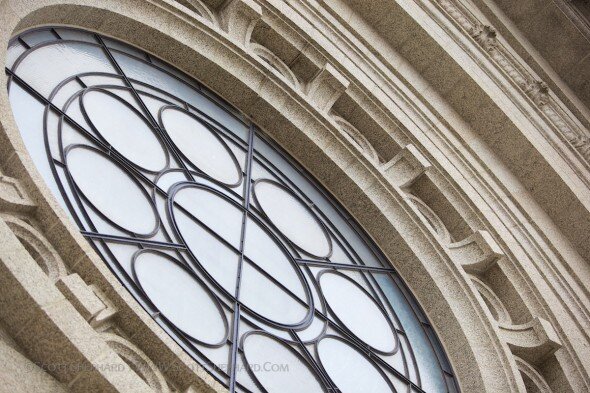 While I was waiting for a few of my students to take photographs of the amazing Cathedral of St. Paul, I stepped outside and took a few shots of the exterior. I had my 70-200 telephoto with me and so I focused on details.It occurs to me that what you see in this photo and how you see it are totally dependent on the photographer. And that's an interesting power to have. . .
While I was waiting for a few of my students to take photographs of the amazing Cathedral of St. Paul, I stepped outside and took a few shots of the exterior. I had my 70-200 telephoto with me and so I focused on details.It occurs to me that what you see in this photo and how you see it are totally dependent on the photographer. And that's an interesting power to have. . .
04-15-12 Textured Geometry
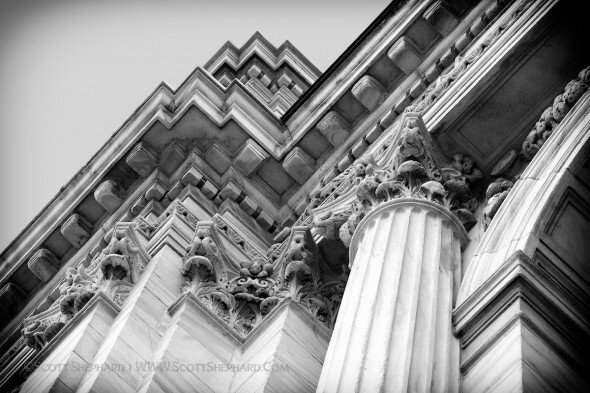 Lately, I have become very conscious of the role that texture plays in my photography and that what attracts my eye is often the textures in a scene, not the scene itself. And because textures are enhanced (or even caused) by light, photography is all about light. The word photography literally means "writing with light." Study this photo and if you can see the textures, you can see the light.Having said that, it's hard not to see all of the textures in this photo, which is of the south facade of the Minnesota State Capitol building in St. Paul. I liked the color version but when I turned it into black and white, the textures became more important than the color.For those who care, these columns are Corinthian in style, which is characterized by the elaborate design at the top, known in architecture as the capital.
Lately, I have become very conscious of the role that texture plays in my photography and that what attracts my eye is often the textures in a scene, not the scene itself. And because textures are enhanced (or even caused) by light, photography is all about light. The word photography literally means "writing with light." Study this photo and if you can see the textures, you can see the light.Having said that, it's hard not to see all of the textures in this photo, which is of the south facade of the Minnesota State Capitol building in St. Paul. I liked the color version but when I turned it into black and white, the textures became more important than the color.For those who care, these columns are Corinthian in style, which is characterized by the elaborate design at the top, known in architecture as the capital.
Classic Portraiture
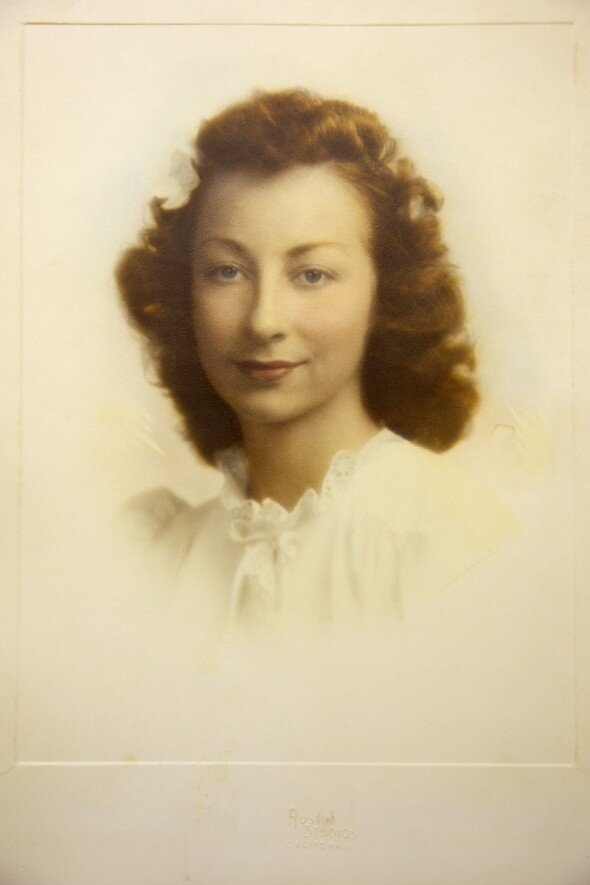 My aunt Betty left South Dakota for California when she was 18. That had to have been a huge leap for a petite girl from the midwest. She went with her oldest sister (my aunt) Phyllis. Phyllis moved back to South Dakota after a few months but Betty stayed for the rest of her life.As close as we can tell, this portrait was taken in 1943 in California when Betty was about 22. That's close to 70 years ago.This photo has powerful personal and family meaning to me but as an occasional portrait photographer and as a photography teacher, it is a good example of what I have said more than once to my young students: a well-posed, well-lit portrait will never go completely out of style.Of course, the hair and clothing fashions of the 1940s have faded. And while a white vignette isn't something you see much of these days, everything else about this portrait still "works," especially the Rembrandt lighting. This photo has a sepia tone to it, though the color would have been applied by hand, since color film was a novelty in the 40s.Finally, as I look at this "analog" picture, I think of the billions of digital files (mine included) that never make their way to paper. If Betty's portrait had been done with a digital camera and if it had only been seen and published on a computer, we wouldn't be looking at it today. What will exist 70 years from now that will decode this and millions of other blogs - and the pictures that illustrate them?
My aunt Betty left South Dakota for California when she was 18. That had to have been a huge leap for a petite girl from the midwest. She went with her oldest sister (my aunt) Phyllis. Phyllis moved back to South Dakota after a few months but Betty stayed for the rest of her life.As close as we can tell, this portrait was taken in 1943 in California when Betty was about 22. That's close to 70 years ago.This photo has powerful personal and family meaning to me but as an occasional portrait photographer and as a photography teacher, it is a good example of what I have said more than once to my young students: a well-posed, well-lit portrait will never go completely out of style.Of course, the hair and clothing fashions of the 1940s have faded. And while a white vignette isn't something you see much of these days, everything else about this portrait still "works," especially the Rembrandt lighting. This photo has a sepia tone to it, though the color would have been applied by hand, since color film was a novelty in the 40s.Finally, as I look at this "analog" picture, I think of the billions of digital files (mine included) that never make their way to paper. If Betty's portrait had been done with a digital camera and if it had only been seen and published on a computer, we wouldn't be looking at it today. What will exist 70 years from now that will decode this and millions of other blogs - and the pictures that illustrate them?
Depth of Field
Textured Light
 I don't think sunlight actually has texture nor can you actually see it - sunlight texturizes the things it illuminates. Right?But, instead of talking philosophy and physics I would rather talk about this photo, which wouldn't exist if my mother-in-law hadn't pointed out the look of the sunlight streaming through open Venetian blinds onto the curtains in Evelyn's nursery at Alecia and Derek's house.Thanks, Glenyce. It's always good to have others help me see things. . .
I don't think sunlight actually has texture nor can you actually see it - sunlight texturizes the things it illuminates. Right?But, instead of talking philosophy and physics I would rather talk about this photo, which wouldn't exist if my mother-in-law hadn't pointed out the look of the sunlight streaming through open Venetian blinds onto the curtains in Evelyn's nursery at Alecia and Derek's house.Thanks, Glenyce. It's always good to have others help me see things. . .
A Stony Gaze
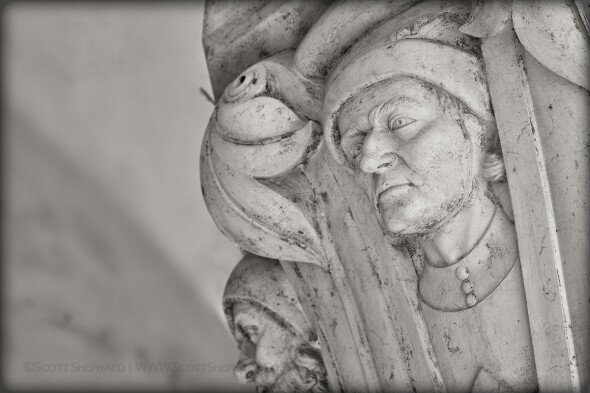 Many of the photos I have posted recently have been resurrected from a fairly large collection of old digital files that have been languishing in a virtual closet. They are a little like old, worn t-shirts that have great sentimental value but should really be turned into rags. My wife even tells me that if I get a new t-shirt, I need to throw an old one away. Imagine that! What if I had to throw one old picture away for every new one I took?Well, that's not in my genes - I blame my parents for being a packrat. And the good thing is that my photos are pretty well organized and that programs like Aperture, iPhoto and Adobe Bridge make it easy to view collections of old pictures.So today's photo was just waiting to see the light of day. It was taken in Venice, Italy, in 2006 and though it looks fairly simple and straight forward, I put about 30 minutes of processing into this to get it the way I wanted it.I'm sure if I had been listening to our tour guide that day, I could tell you more about this man. But I'm afraid I was caught up in my photography. . . .
Many of the photos I have posted recently have been resurrected from a fairly large collection of old digital files that have been languishing in a virtual closet. They are a little like old, worn t-shirts that have great sentimental value but should really be turned into rags. My wife even tells me that if I get a new t-shirt, I need to throw an old one away. Imagine that! What if I had to throw one old picture away for every new one I took?Well, that's not in my genes - I blame my parents for being a packrat. And the good thing is that my photos are pretty well organized and that programs like Aperture, iPhoto and Adobe Bridge make it easy to view collections of old pictures.So today's photo was just waiting to see the light of day. It was taken in Venice, Italy, in 2006 and though it looks fairly simple and straight forward, I put about 30 minutes of processing into this to get it the way I wanted it.I'm sure if I had been listening to our tour guide that day, I could tell you more about this man. But I'm afraid I was caught up in my photography. . . .
02-14-12 Monument
 This is a shot of the front of the Terry Redlin Center in Watertown, South Dakota. And I think it is a good example of the power of the photographer to direct the viewer's attention to details and views that he or she wouldn't or couldn't get independently. Most people see the Redlin center like this.I chose to focus on a very small section of columns just under the triangular pediment. I also chose an oblique angle. Finally, I used a telephoto lens to compress the focal plane, something the human eye can't do.Am I manipulating you? Youbetcha!And, as if you don't already feel used enough, how about my black and white treatment compared to "real" color? I don't know about you, but I like the b&w version better because the photo seems more unified. The colored version tends to allow you look at features in this scene in a way I don't want you to.This is all in a day's work and these are the kind of things true photographers think about. And my goal in life is to keep getting closer to being a "true photographer."
This is a shot of the front of the Terry Redlin Center in Watertown, South Dakota. And I think it is a good example of the power of the photographer to direct the viewer's attention to details and views that he or she wouldn't or couldn't get independently. Most people see the Redlin center like this.I chose to focus on a very small section of columns just under the triangular pediment. I also chose an oblique angle. Finally, I used a telephoto lens to compress the focal plane, something the human eye can't do.Am I manipulating you? Youbetcha!And, as if you don't already feel used enough, how about my black and white treatment compared to "real" color? I don't know about you, but I like the b&w version better because the photo seems more unified. The colored version tends to allow you look at features in this scene in a way I don't want you to.This is all in a day's work and these are the kind of things true photographers think about. And my goal in life is to keep getting closer to being a "true photographer."


